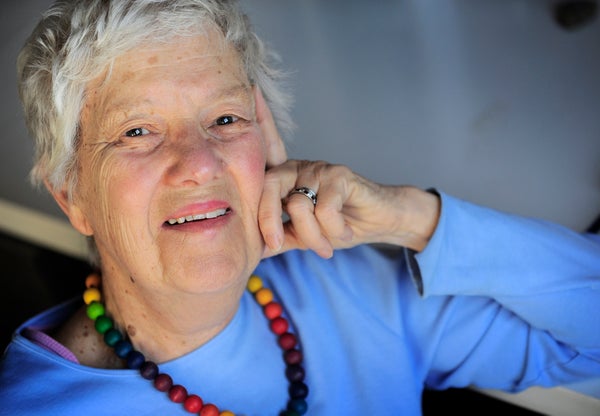“Could I come to the telescope with you?” I innocently asked the late astronomer Vera Rubin that question a few weeks after I met her in 2007.
Even then, in her late 70s, Rubin continued her trips to places such as Kitt Peak National Observatory to scour the outermost edges of far-flung galaxies in order to clock how quickly the galaxies’ stars whipped around their cores. In our solar system, Mercury whips around the sun at high velocity, while Pluto merely plods along, and astronomers naturally assumed that stars close to a galaxy’s core would similarly move faster than stars out at the edge.
Yet years of work with her collaborator Kent Ford and other colleagues had revealed that this isn’t true; the stars farthest out tend to move just as swiftly as stars closer in. In the 1960s and 1970s, this observation shocked scientists. It implied that the gravity from some invisible form of matter was making the outermost stars move unexpectedly quickly—and that there was vastly more matter in the cosmos that astronomers originally thought. It meant, as Rubin so adeptly noted in 1985, the universe had been playing a trick on us, keeping the majority of the universe’s matter hidden from view.
On supporting science journalism
If you're enjoying this article, consider supporting our award-winning journalism by subscribing. By purchasing a subscription you are helping to ensure the future of impactful stories about the discoveries and ideas shaping our world today.
I had not known about the universe’s trick until I came across a description of Rubin’s research while interning at the National Air and Space Museum in Washington, D.C., and wandering around the Explore the Universe exhibit. Reading about Rubin, my brain buzzed. Who was she? Why hadn’t I heard more about her? Did we really not know what most of the universe was made of? I peppered my supervisor, David DeVorkin, with these questions and others. He pointed me to Rubin’s collection of essays, Bright Galaxies, Dark Matters. A day later he asked: “Would like you to interview Vera?”
Absolutely, yes, I said. DeVorkin was working on Rubin’s oral history, which he wanted to finish. I read and researched, preparing questions. On the day of the interview, Rubin welcomed us into her office at the Department of Terrestrial Magnetism, the same one she’d shared with Ford for decades. Dozens of stories and anecdotes later, we headed to Rubin’s home not far from Chevy Chase, where both Vera and Robert Rubin, her husband, answered our questions. The couple finished each other’s thoughts. They made each other laugh. In that afternoon, their love and respect for each other were obvious, even unspoken. That’s the kind of relationship I want, I remember thinking.
Finding a partner who was patient, kind and as invested in your career as in their own, was advice Rubin often gave in talks and interviews. She not only said it. She lived it. She also showed me how to make others feel important. Even though I was a stranger, an intern, she listened to me. She asked me questions about my aspirations. She encouraged me. She didn’t have to do that. She chose to.
Because I felt Rubin was so approachable, I dared to write and ask to go to the telescope with her. She thanked me for my “sweet letter,” and in a September 20, 2007 e-mail wrote, “The answer is yes, but … telescope time is very valuable and making mistakes is very easy.” She told me when to arrive at the telescope, when to watch her work and when to ask questions. And then she said, “Bring a warm coat or jacket … we’ll be observing in a warm room but have to go out to the telescope sometimes.” She was open to my request, set boundaries and still looked out for my well-being. High expectations and warmth (no coat pun intended) again were traits I wanted to emulate.
On that crisp night in mid-November 2007, we met at Kitt Peak. That first night there, she flicked a switch, and the darkness of the telescope’s dome swallowed her. She quickly and confidently took a few steps, grabbed the staircase railing, and climbed up. At the top, she slid her hand across the door, found the knob and pushed. Nothing happened. Like a football lineman, she lowered her center of gravity and threw her weight against the hinged hunk of metal, bumping it open with her hip. That scene became the opening of my book, Bright Galaxies, Dark Matter and Beyond, a tour of Rubin’s life. In it, I try to convey her grace, wit and grit, even in the face of sexism and sometimes scorn for her research. I also explore the life lessons she taught me: Listen, speak up against injustice, be fearless and, above all, be curious.
“Each one of you can change the world,” she wrote in Bright Galaxies, Dark Matters, “for you are made of star stuff, and you are connected to the universe.”*
This essay was adapted from the author's new book Bright Galaxies, Dark Matter and Beyond.
This is an opinion and analysis article; the views expressed by the author or authors are not necessarily those of Scientific American.
*Editor’s Note (8/19/21): This paragraph was edited after posting to replace an unsubstantiated quote.
